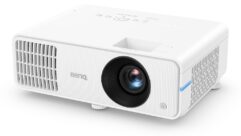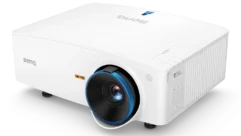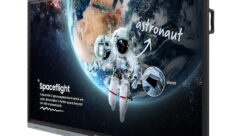Is There A Laser In Your Future?
Although laser imaging technology has been around for a few years, we haven’t seen it in a projection TV application ?until now.
THIS PAST April, Mitsubishi Electronics showed a laser-powered rear-projection TV as part of its 2006 product line show. This demo didn’t exactly come out of the blue; Mitsubishi had private meetings at CES 2006 to let selected customers inspect this technological marvel. But the event, held at the Hyatt Huntington Beach Resort in California, was the first public demonstration of a laser projection system for consumer TVs in a long time.
The idea of using lasers to illuminate images isn’t new. In theory, it’s been possible for a long time — if the lasers are bright enough, and if the lasers and their power supplies can be made small enough.
Problem was, lasers required large power supplies and blue lasers didn’t generate sufficient power to be practical. That changed a few years back with the development of blue diode lasers capable of 5 or more watts of power, matching the energy developed in red and green versions.
The Mitsubishi demo used a special type of laser known as a C-SEL, or Cavity Surface Emitting Laser, manufactured by Novalux Corp. Three individual laser emitters (red, green, and blue) are manufactured on a semiconductor surface in precise alignment.
The power ratings of each laser vary, but for a 50-inch microdisplay rear-projection TV the red laser would produce just less than 3 watts at 620 nanometers, the green, 3 watts at 532 nanometers, and the blue, 2.5 watts at 465 nanometers. That would be sufficient to replace a 150-watt UHP short-arc lamp, which might at best last 4,000 to 5,000 hours before reaching half-brightness.
By using laser light, which is coherent (focused) and already polarized, Novalux claims that many optical components in rear- and front-projection systems can be eliminated, such as condensers and light integrators, polarizers and polarizing films, and color wheels and dichroic filters. In theory, laser light could also be used to illuminate LCD flat-panel displays by employing a sequential color scanning system.
Two other potential advantages accrue to lasers: They’re instant-on, instant-off devices, and can operate for 50,000 hours or more before reaching half-life. That has obvious appeal to rear-projection TV manufacturers, particularly those companies trying to hold off the onslaught of low-cost plasma and LCD flat-panel TVs.
So it’s all positive, right? Not exactly. The price we pay for the tightly focused coherent light from a laser is speckle, a shifting, grain-like optical interference pattern that’s the signature of a laser light source. If you’ve ever been to a laser light show at a planetarium, or seen laser text and images projected, you know what speckle is and how distracting it can be.
To successfully implement a laser light engine, we’ve got to eliminate as much speckle as possible. It’s even more of a problem with rear-projection TVs, as their screens already have a grain-like micro lens structure that creates optical beat frequencies with the ever-shifting speckle from the laser.
Sure enough, the Mitsubishi demo projector had plenty of speckle, particularly when saturated colors such as green were being shown. Several members of the press standing near me at the demo noticed the combination of grain and speckle and commented on how soft the HD images looked, as well as the unearthly shades of red and green solid colors that were seen.
Is There A Laser In Your Future?
Although laser imaging technology has been around for a few years, we haven’t seen it in a projection TV application ?until now.
How do you get rid of speckle? By diffusing the laser’s beam as much as possible. Of course, it’s no longer coherent as a result, which means the light output drops off considerably. (You can’t get something for nothing!)
Back in 1998, I took a trip to Portsmouth, NH, to visit the offices of the Corporation for Optical Laser Research (COLOR), a company that, at the time, had a subsidy from Sony to develop a practical light engine for a cinema-grade projector. The lasers would work in conjunction with a light modulator known as the grating light valve, or GLV. (Remember the GLV?)
I was shown, among other things, a room with a 9- by 12-foot optical bench, loaded with diffusers and mirrors, focusing red, green, and blue laser beams into the combining prism of a Sony XGA-resolution LCD projector. By the time the image got to the screen, it was largely free of speckle, had saturated colors — and wasn’t terribly bright.
Not all that impressive, considering the wall of 6-foot-tall rack units powering and controlling the lasers. (Remember, I said laser illumination for projectors was possible back then, not necessarily practical.) Effectively, the COLOR engineers had created the world’s largest portable LCD projector.
The Mitsubishi line show demo, if nothing else, generated lots of good PR for the company. As to its claim that the product would be at retail by the fourth quarter of 2007, I’d have to be pretty skeptical. Aside from the speckle issue, lasers are considered hazardous because their coherent light can literally cook your retina if you stare directly at them.
That means the laser imaging assembly would have to be completely sealed and accessible only by the factory. Considering the power supply and lasers for the Mitsubishi demo weren’t even inside the ultra-slim 10-inch RPTV cabinet, but located below it in a large black box with numerous cooling fans, there are other packaging issues to be addressed before this product is marketable.
Novalux isn’t the only company showing demonstrations of laser engines. Photonics giant Coherent Inc. recently exhibited at the UDSC-Needham Investment Conference in New York City in March, and had hacked together a laser projection engine for a Samsung 52-inch DLP RPTV. The green laser was a straight diode design, while the red and blue lasers were pumped. It, too, took up the insides of a large support chassis with cooling fans positioned under the TV.
The Coherent/Samsung demo did away with the standard multi-segment color wheel, which also removed the single-chip DLP rainbow artifact I find so distracting. I didn’t see the rainbow during the Mitsubishi demo either, and am guessing it was also using sequential laser color illumination with a fast refresh rate, as its presentation slides illustrated.
One other issue with laser color: Both of these demonstrations talked about the laser’s ability to far exceed the NTSC color gamut. In fact, the green, red, and blue coordinates of lasers at 620, 530, and 460 nanometers create a color space almost equal to the visible color gamut! All fine and dandy, except that the program material being displayed on these TVs is coded into specific color spaces that are much smaller, such as REC 709 and SMPTE-C.
So it doesn’t do any good to exceed the level of green by a magnitude of two or three, nor does it make much sense to push reds into candy-apple territory on such a TV. The smart move is to make sure all of the colors within a specific gamut (and that could include the new DCI cinema color space) are reproduced accurately, something that obviously wasn’t happening during the Mitsubishi demo.
Is There A Laser In Your Future?
Although laser imaging technology has been around for a few years, we haven’t seen it in a projection TV application ?until now.
FEEDBACK
So, is there a laser projection engine in your future? That depends. You’ll probably see LEDs pick up the slack sooner, as short-arc mercury lamps are phased out. It’s true that LEDs aren’t terribly energy-efficient, but they don’t suffer from speckle, and are naturally diffuse illuminants with specific color wavelengths. Four companies showed LED rear-projection TVs at CES 2006, and that’s four times as many that showed a laser product.
To comment on this article, email the Pro AV editorial staff at [email protected].
Pete Putman is a contributing editor for Pro AV and president of ROAM Consulting, Doylestown, PA. Especially well known for the product testing/development services he provides manufacturers of projectors, monitors, integrated TVs, and display interfaces, he has also authored hundreds of technical articles, reviews, and columns for industry trade and consumer magazines over the last two decades. You can reach him at [email protected].










